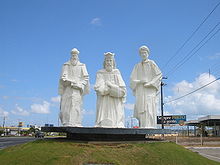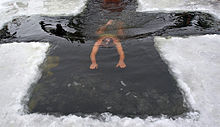Epiphany (holiday)
![]()
Epiphany, Epiphany and Epiphany festival are redirections to this article. For other meanings, see Apparition of the Lord (disambiguation), Epiphaneia, and Epiphanius.
![]()
Epiphany and Epiphany are redirections to this article. For the figures of the Christian tradition, see Magi.
Epiphany, Epiphania, Epiphanie (from the ancient Greek ἐπιφάνεια epipháneïa, Latinized epiphanīa "appearance") or Epiphany is the original and still common name in the Protestant Church of a feast in Christianity celebrated on 6 January; in the current edition of the Order of Pericopes it is called "Feast of the Appearance of the Lord: Epiphany". In parts, especially in the Orthodox churches, the term theophany (θεοφάνεια theophanīa "appearance of God") is also used synonymously with this.
In the Catholic Church it is called the Solemnity of the Epiphany of the Lord (Sollemnitas in Epiphania Domini), popularly and in many calendars also Epiphany, Epiphany, Epiphany and Epiphany, regionally sporadically until today, among others, also as Great New Year, High New Year, High New Year or Supreme. In Austria this day is also called Christmas Twelfth. This name is probably derived from the old custom of celebrating Christmas for twelve days, the last day of which was the Feast of the Epiphany.
The feast is attributed by the Western Churches to the Adoration of the Child by the Wise Men from the East. In the Orthodox Churches it is the Solemnity of the Baptism of the Lord and the Revelation of the Most Holy Trinity.

Altarpiece by Josef Moroder-Lusenberg in the parish church of Ortisei in Val Gardena (1888)

Larger-than-life monument of the Magi (Portuguese "Três Reis Magos") in Natal (Brazil), 2004
Calendar day
Epiphany and the Nativity were originally celebrated in one feast on January 6. In the Armenian Apostolic Church this is still the case today, whereas the feast of the Nativity of Christ was moved to December 25 in the Roman State Church in 432 AD. The calendar reform of 1582 also shifted the feasts of the Orthodox and Catholic Churches against each other. December 25 of the Julian calendar long fell on January 6, and in the 20th and 21st centuries falls on January 7 of the Gregorian calendar, yet Orthodox churches celebrate Christmas on December 25. Since the Armenian Christians in the Holy Land also observe the Julian calendar, Christmas is celebrated there together with the feast of the Baptism of Christ as Epiphany on the Julian 6th of January, according to the Gregorian calendar on the 19th of January.
History and contents
Already in Hellenistic Egypt, the birth of the sun god Aion from the virgin Kore was celebrated on the night of January 5-6. On the day of January 6, the drawing of the healing water from the Nile followed.
In ancient Greece, the words theopháneia and epipháneia were used to describe the appearance of a deity, and the former was also used to describe the display of all the images of the gods at a festival in Delphi.
In the ancient Roman imperial cult in the Hellenistic east of the Roman Empire, a holiday formed that included the divine appearance of the Divus as part of the ceremonial. The rite was also celebrated at the beginning of January and was based on the epiphany of Iulius Caesar, who was greeted and worshipped by the people as savior and living god (probably Divus Iulius) when he crossed the Rubicon on January 10, 49 BC. Basically, the epiphany meant nothing else than the adventus, the arrival of the Roman ruler and "his auspicious entry into a city".
At the latest in the 2nd century, the Christian Epiphany or Theophany festival arose in the Eastern Church, which by the 4th century had overlaid the ancient ritual of the imperial cult. After the Constantinian turn, some elements of the pre-Christian cult of Epiphany, insofar as they could be applied to Christ, entered the liturgy. The imperial Epiphany rites persisted in Byzantium until the fall of the Eastern Roman Empire, but in an increasingly limited fashion as the position of the divinized Caesars as Roman state gods was relegated to the role of the living ruler as Christ's representative. The original date of the epiphany is unknown. The oldest secure source, in addition to May 20, gives January 10 as the main date, but also the 6th day of the new year, which is in common use today. On this day, reports Clement of Alexandria, the Gnostic sect of the Basilidians celebrated the baptism of Jesus, through which, according to their understanding, the man Jesus became the Son of God.
By "appearance" is meant the human presence of God in the person of Jesus Christ. The birth of Jesus is commemorated with the adoration of the Jewish shepherds, the adoration of the wise men (Mt 2 EU), his childlike ministry until his baptism in the Jordan (Mt 3,13-17 EU) and his first miracle at the wedding at Cana (Joh 2,1-11 EU). The Western Church, which celebrated Jesus' birth on December 25 (Christmas), later adopted the feast of the Epiphany, but instead of the birth, celebrated the "three miracles" of the Adoration of the Magi (also called the "Adoration of the Wise Men"), Jesus' baptism in the Jordan, and the wedding at Cana. The feast can be called the "Feast of the Kings" because it especially emphasizes the appearance of Jesus Christ's royal power and His worship as King. This idea was elevated by Pope Pius XI in 1925 to the theme of a feast of its own, the Feast of Christ the King.
The current reading and pericope orders in the Protestant, Catholic and Anglican churches refer with the Gospel (Mt 2:1-12 EU) above all to the adoration of the wise men, so that this festival content is naturally in the foreground today. The Old Testament reading Is 60:1-6 EU and the epistle Eph 3:2-3a.5-6 EU, which are required in the Catholic order of readings, are also provided for in the Protestant order of pericopes in the fifth and second rows respectively. There, further readings are added: Jn 1:15-18 EU (III), Col 1:24-27 EU (IV) and 2 Cor 4:3-6 EU (VI).
The baptism in the Jordan is assigned to the following Sunday - in the Roman Catholic Church called the feast of the Baptism of the Lord, in the Protestant church year as the 1st Sunday after Epiphany -, the revelation at the wedding at Cana to the following "2nd Sunday after Epiphany" (Protestant) or the "2nd Sunday in the cycle of the year" in reading year C (Catholic). In previous Protestant pericopes, the Gospel of the Baptism of Jesus (Mt 3:13-17 EU) was still read on Epiphany.
It is believed that the Epiphany was not liturgically recognized in the Western Church until after the introduction of Christmas there on the feast day of Sol Invictus, that is, not until the 4th century at the earliest.
Since the introduction of Christmas on December 25, the Eastern Church celebrates with Epiphany in the church year only the "baptism of Jesus", in the Slavs connected with a blessing of water ("Great Consecration of Water") and often a procession to a body of water. Since part of Orthodoxy, especially in Russia and Serbia, liturgically adheres to the Julian calendar, Christmas is currently celebrated in the countries concerned on 7 January and Epiphany only on 19 January.
The Feast of the Epiphany is celebrated in the liturgy of the Catholic Church as the Solemnity of the Epiphany of the Lord. The calendar of the Protestant Church also includes the feast of Epiphany. Until 1955, Epiphany also had a vigil day on January 5 and an octave ending on January 13; what remained of this after its abolition by Pope Pius XII was the former octave day, on which the feast of the Baptism of the Lord was celebrated until the liturgical reform of the SecondVatican Council. The vigil of the Feast of the Apparition has its own liturgical proprium.

Traditional ice bathing at Epiphany on 19 January in Kazan (Russia)
Search within the encyclopedia